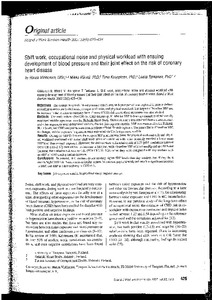Shift work, occupational noise and physical workload with ensuing development of blood pressure and their joint effect on the risk of coronary heart disease

Virkkunen, Hanna ; Härmä, Mikko ; Kauppinen, Timo
Scandinavian Journal of Work, Environment and Health
2007
33
6
425-434
heart diseases ; job exposure relation ; longitudinal analysis ; noise ; physical workload ; registers of occupational diseases ; shift work
Occupational diseases
English
"Objectives The change in systolic blood pressure (SBP) over an 8-year period was explored in groups defined according to exposure to shift work, occupational noise, and physical workload. The impact of baseline SBP and its increase in relation to coronary heart disease (CHD) risk due to these exposures was also studied.Methods The study cohorts (N=1288 for CHD follow-up, N=884 for SBP follow-up) consisted of industrially employed middle-aged men from the Helsinki Heart Study. Shiftwork status was obtained from a questionnaire, and other exposures were determined with the Finnish job-exposure matrix. SBP was measured in the Helsinki Heart Study, and CHD end points were obtained from official Finnish registers. The joint effects of baseline SBP, its change, and the exposure in question were estimated via Cox´s regression models.Results During the SBP follow-up, the steepest SBP gradient was found for physical workload only and physical workload combined with noise; shift work alone or combined with noise primarily entailed a lower mean SBP level than no such exposure. However, the shift workers had a relative risk of 1.71 [95% confidence interval (95% CI) 1.01–2.87] even without an increase in SBP, but, with a baseline SBP of =140 mmHg and an additional increase, their relative risk rose to 4.62 (95% CI 2.31–9.24) when they were compared with day workers with an SBP of <140 mmHg and no increase.Conclusions In general, shift workers do not develop higher SBP levels than day workers, but, if they do, it entails high CHD risk. Noise shows a similar pattern. In contrast, physical workload entails a significant increase in SBP, and SBP is a key pathway to CHD risk."
Digital
The ETUI is co-funded by the European Union. Views and opinions expressed are however those of the author(s) only and do not necessarily reflect those of the European Union or the ETUI.